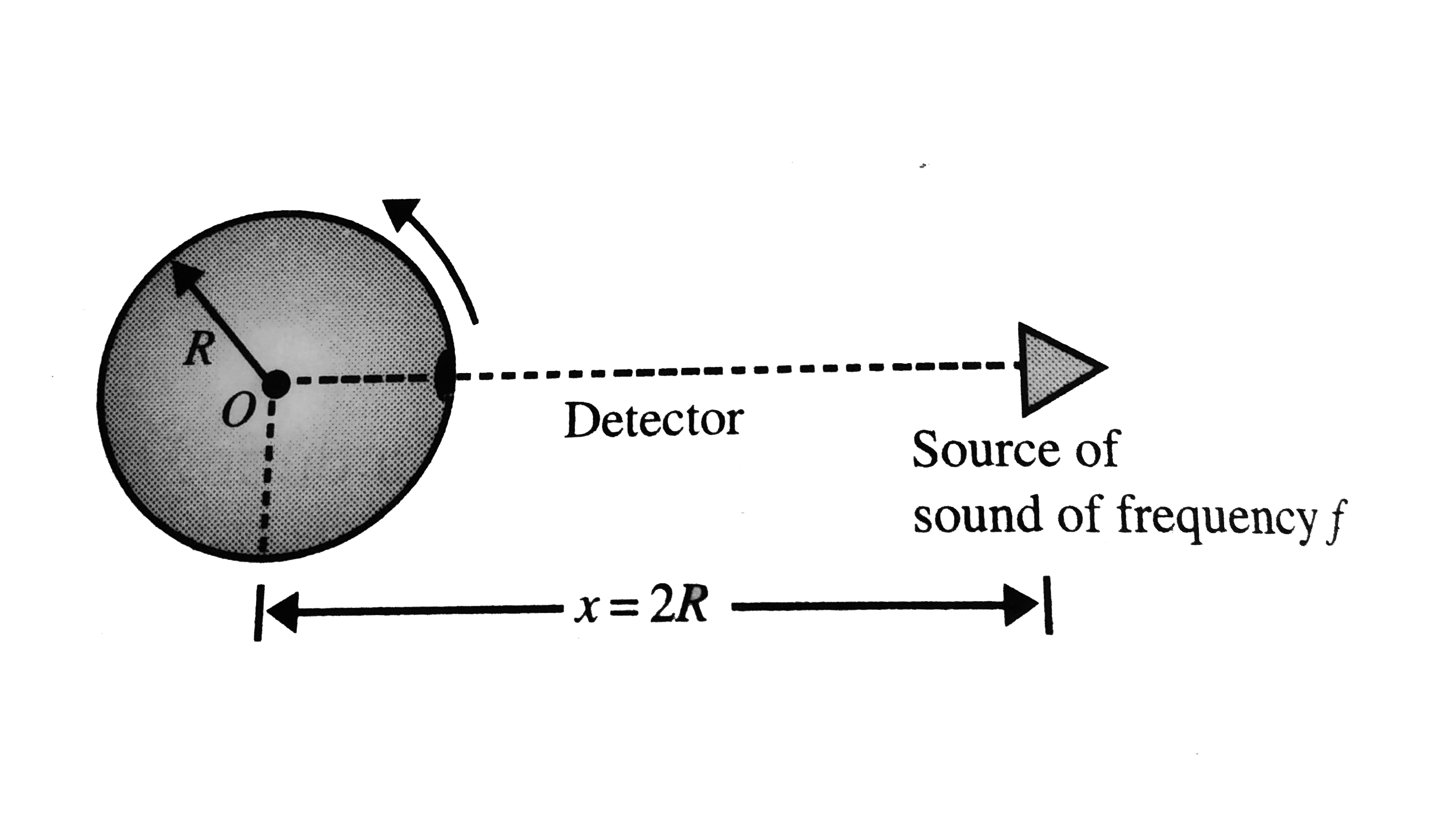
A source of sound and detector are arranged as shown in Fig. The detector is moving along a circle with constant angular speed ω. It start from the shown location in anticlockwise direction at t=0
(Take velocity of sound in air as v)
Find the time interval between minimum and maximum frequency as received by the detector.
π(3ω)
5π(3ω)
4π(3ω)
πω
The correct Answer is:C

The instant at which the detector hears maximum and minimum frequencies are shown in Fig. A corresponds to minimum frequency while B corresponds to maximum frequency
cosθ=R2R=12
⇒θ=π3
Let the detector reaches A in time t0 (measured from the starting instant). then
θ=ωt0
⇒π3=ωt0
⇒t0=π3ω
let the detector reaches B in time t01 (measured from A). Then,
2π−2θ=ω×t01
⇒t01=4π3ω
The time taken after which the detector hears the maximum frequency for the first time is
t0+t01=5π3ω
The interval between maximum and minimum frequencies as received by the detector for the first time is
t01=4π3ω
Topper's Solved these Questions
- SOUND WAVES AND DOPPLER EFFECTBook:CENGAGE PHYSICSChapter:SOUND WAVES AND DOPPLER EFFECTExercise:Integer
Explore 16 Videos
- SOUND WAVES AND DOPPLER EFFECTBook:CENGAGE PHYSICSChapter:SOUND WAVES AND DOPPLER EFFECTExercise:Assertion-Reasoning
Explore 24 Videos
- RIGID BODY DYNAMICS 2Book:CENGAGE PHYSICSChapter:RIGID BODY DYNAMICS 2Exercise:Interger
Explore 2 Videos
- SUPERPOSITION AND STANDING WAVESBook:CENGAGE PHYSICSChapter:SUPERPOSITION AND STANDING WAVESExercise:Comprehension Type
Explore 5 Videos
Similar Questions
A source is moving on a circle of radius 3m with constant angular velocity ω=5rads−1. If the observer is at a distance 5 cm from the centre of the circle, the time interval between the maximum and minimum frequency received by the observer is
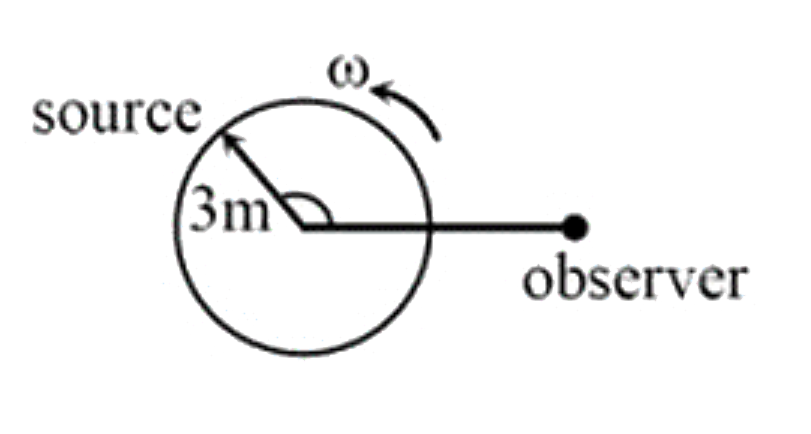
View SolutionA sound source capable of producing sound of variable frequencies is located at a distance of 1 m from a reflecting wall as shown in the figure. A detector D is lying at a point shown in the figure. The various distances are also indicated. If the speed of sound in air is 340 ms−1, find the frequencies of sound within the audible range, which will have maximum intensity at detector?

View Solution
Knowledge Check
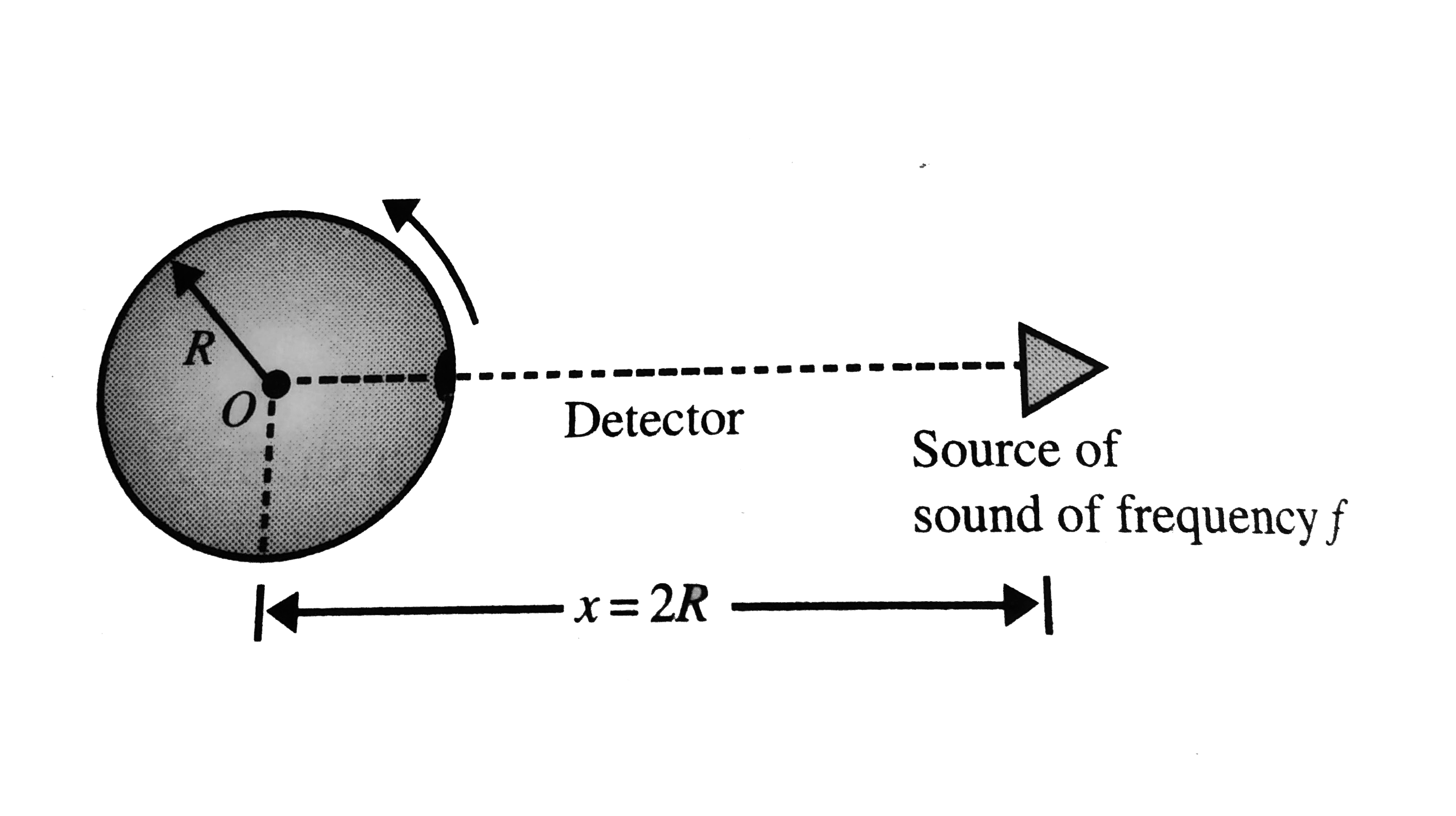
A source of sound and detector are arranged as shown in Fig. The detector is moving along a circle with constant angular speed ω. It start from the shown location in anticlockwise direction at t=0
(Take velocity of sound in air as v)
Q. Find the time at which the detector will hear the maximum frequency for the first time.Aπ(3ω)B5π(3ω)C4π(3ω)Dπω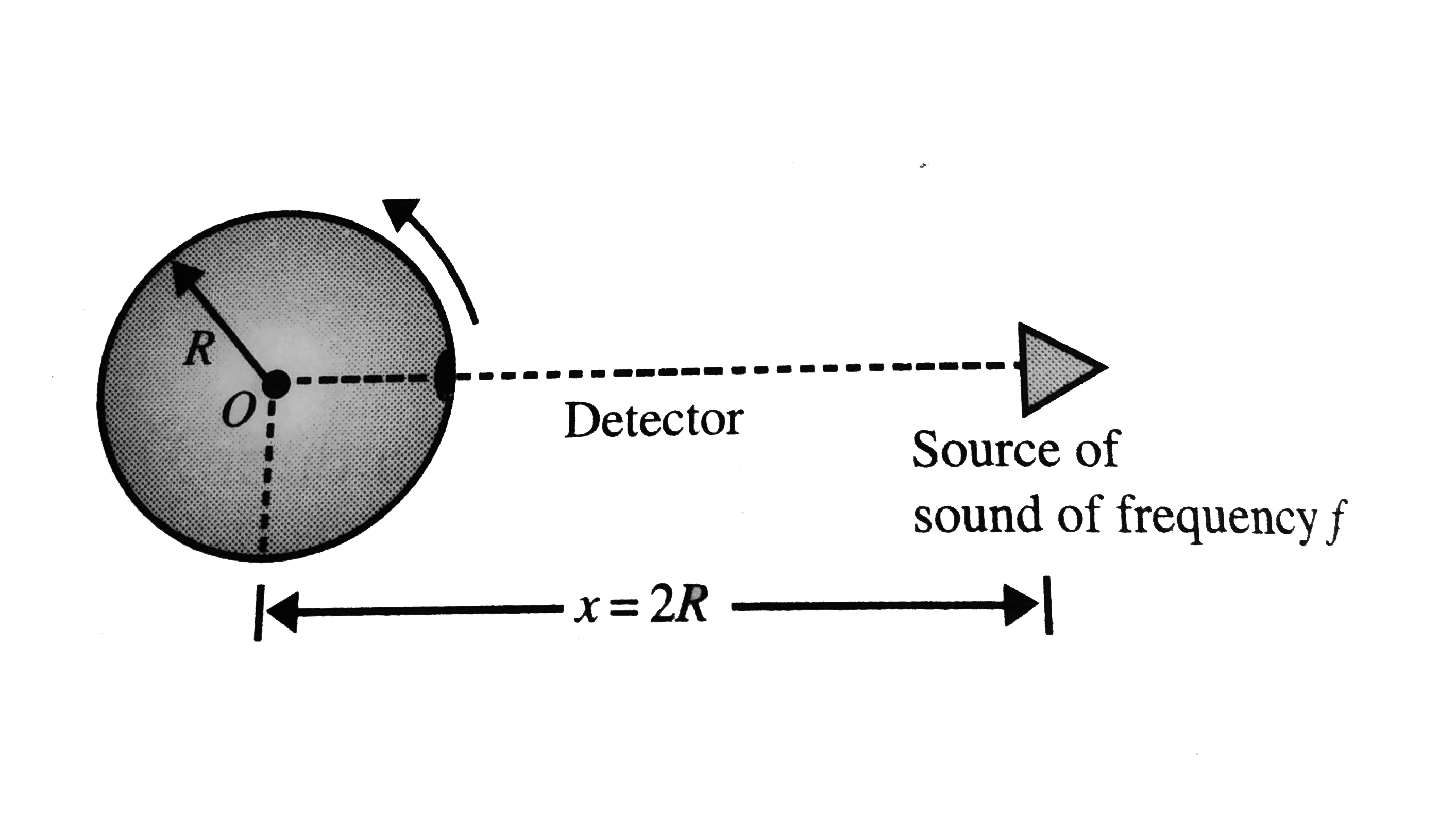
A source of sound and detector are arranged as shown in Fig. The detector is moving along a circle with constant angular speed ω. It start from the shown location in anticlockwise direction at t=0
(Take velocity of sound in air as v)
What is the frequency as received by detector, when it rotates by an angle π2?AfBv−ωRv×fCv−ωRv×fDv−ωR×2√5v×f
A source of sound and detector are moving as shown in Fig. at t=0. Take velocity of sound wave to be v. For this situation mark out the correct statement(s).AThe frequency received by the detector is always greater than f0BInitially, frequency received by the detector is greater than f0, becomes equal to f0, and then decreases with the time.CFrequency received by the detector is equal to f0 at t=dcotθ0(2v0).DFrequency received by the detector can never be equal to f0
A source of sound of frequency 256 Hz is rotating in a circle of radius 3 m with angular speed of 20 rad/s. A listener is standing at rest along the line of centre of the circle. Under which position of the source of sound the listener will hear sound of
(a) maximum frequency
(b) minimum frequency
(c) same frequency as the frequency of source.
View Solution
A source S emitting sound of 300 Hz is fixed of block A which is attached to free end of a spring SA as shown in the figure. The detector D fixed on block B attached to the free end of spring SB detects this sound.
The blocks A and B are simultaneously displaced towards each other through of 1.0 m and then left to vibrate. Find the maximum and minimum frequencies of sound detected by D if the vibrational frequency of each block is 2 Hz (velocity of sound is 340 m/s).
View Solution(a) A source of sound S and a detector D are placed at some distance from one another. A big cardboard is placed near the detector and perpendicular to the line SD as shown in figure. It is gradually moved away and it is found that the intensity changes from a maximum to a minimum as the board is moved through a distance of 20cm. Find the frequency of the sound emitted. Velocity of sound in are is 336m/s.

(b) A source emitting sound of frequency 180Hz is placed in front of a wall at a distance of 2m from it. A detector is also placed in front of the wall at the same distance from it. find the minimum distance between the source and the detector for which the detector detects a maximum of sound . Speed of sound in air =360m/s.
View SolutionA sound source, detector and a cardboard are arranged as shown in figure. The wave is reflected from the cardboard at the line symmetry of source edetector. Initially the path difference between the reflected wave and the direct wave is one third of the wavelength of sound. Find the minimum distance by which the cardboard should be moved upwards so that both waves are in phase.

View SolutionAn electron is at P t=0 It is circulating in anticlockwise direction with a constant angular speed ω along the shown circular path. Magnetic field at Q(CQ=2R, where R is radius of the circular) will be recorded as zero at times)
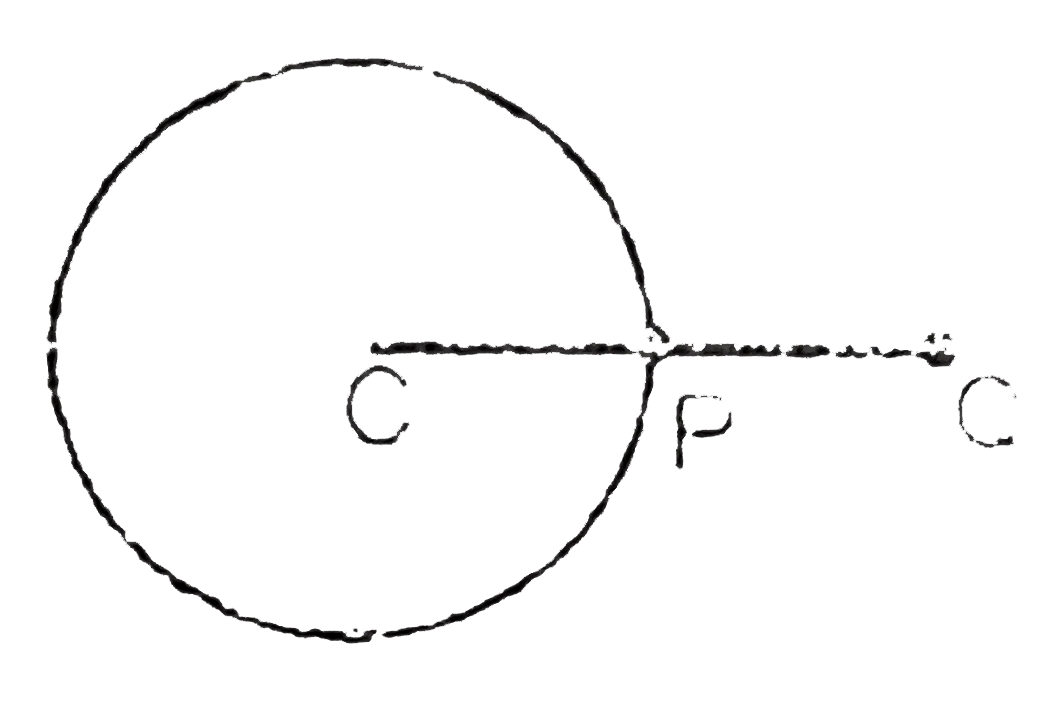
View Solution